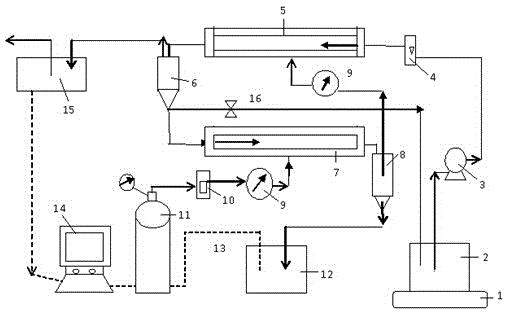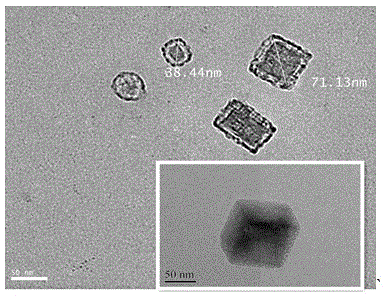Co-production method for nano calcium carbonate through marsh gas purification
A nano-calcium carbonate and biogas technology, applied in the field of separation engineering, can solve the problems of low energy utilization efficiency and limited application range, and achieve the effects of small footprint, small number of equipment, and simple control
- Summary
- Abstract
- Description
- Claims
- Application Information
AI Technical Summary
Problems solved by technology
Method used
Image
Examples
Embodiment 1
[0040] like figure 1 The device for biogas purification and co-production of nano-calcium carbonate shown includes a raw material storage tank 2, a membrane reactor a5, a gas-liquid separator a6, a membrane reactor b7, a gas-liquid reactor b8 and a product storage tank 12 connected in sequence, And the biogas tank 11 and the biogas conveying assembly separately connected to the membrane reactor b8, the gas phase outlet of the gas-liquid separator b8 is connected to the membrane reactor a5; the gas phase outlet of the membrane reactor a5 is connected to the CO 2 A sensor 15; a diverter valve 16 is also provided between the gas-liquid separator a and the raw material storage tank.
[0041] Wherein, the membrane reactor a and the membrane reactor b are the same known structure, the average pore diameter of the dispersed membrane is 6 μm, and 19 microchannels are arranged side by side, and the gas phase is pressed into the other phase by pressure, and the two phases are in Rapid...
Embodiment 2
[0047] The quicklime is digested, matured, filtered and diluted to prepare the lime milk concentrate. In the Ca(OH)2 suspension with a concentration of 3%, add sucrose with a mass ratio of 0.1%, inject it into the raw material storage tank, and enter the membrane reactor a and membrane reactor b in sequence through the control of the pump and flowmeter, and flow to the membrane Feed biogas into reactor b, control the liquid flow rate, and terminate the reaction at pH=6.72. The obtained nano calcium carbonate solution is centrifuged and dried at 70°C. The gas discharged from the membrane reactor a enters the membrane reactor a and then undergoes a purification reaction. The methane content in the carbonized and purified biogas reaches 96% through gas phase detection. Observed under a transmission electron microscope, the calcium carbonate particles have agglomeration phenomenon, the particle size distribution is 40-100nm, and the dispersion effect is not ideal. This shows that...
Embodiment 3
[0049] The quicklime is digested, matured, filtered and diluted to prepare the lime milk concentrate. In the Ca(OH)2 suspension with a concentration of 6%, add sucrose with a mass ratio of 0.5%, inject it into the raw material storage tank, and enter the membrane reactor a and membrane reactor b in sequence through the control of the pump and flow meter, and feed the reaction Feed biogas into device b, control the liquid flow rate, and terminate the reaction at pH=6.82. The obtained nano-calcium carbonate solution is centrifuged and dried at 60°C. The gas discharged from the membrane reactor a enters the membrane reactor a and then undergoes a purification reaction. The methane content in the carbonized and purified biogas reaches 98% through gas phase detection. Observed under a transmission electron microscope, the calcium carbonate particles are cubic (see figure 2 ), the dispersion is good, and the average particle size distribution is about 50nm. This shows that when t...
PUM
| Property | Measurement | Unit |
|---|---|---|
| pore size | aaaaa | aaaaa |
| particle diameter | aaaaa | aaaaa |
| particle size | aaaaa | aaaaa |
Abstract
Description
Claims
Application Information
 Login to View More
Login to View More - R&D
- Intellectual Property
- Life Sciences
- Materials
- Tech Scout
- Unparalleled Data Quality
- Higher Quality Content
- 60% Fewer Hallucinations
Browse by: Latest US Patents, China's latest patents, Technical Efficacy Thesaurus, Application Domain, Technology Topic, Popular Technical Reports.
© 2025 PatSnap. All rights reserved.Legal|Privacy policy|Modern Slavery Act Transparency Statement|Sitemap|About US| Contact US: help@patsnap.com


